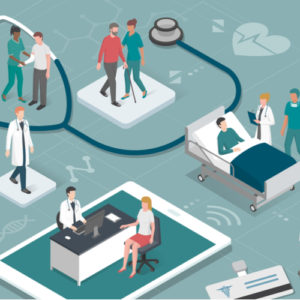The key barriers in healthcare for accessibility include language, financial, attitudes, and also physical and logistical barriers. As a point of contention among partisan political groups, the healthcare crisis in America has been clouded by competing agendas. Specifically, the media’s focus is on large insurance carriers and legislative actions taken by the state like the Affordable Care Act. However, little or no credence is paid to the many social and cultural nuances that affect one’s access to healthcare. While the cost of healthcare services and the structure of our healthcare reimbursement system certainly contribute to lack of access, many social barriers that prospective patients face are being overlooked. As such, this report will comprehensively review both the financial and social barriers to healthcare.
Patient Education and Attitudes
Regardless of how affordable healthcare is, if a prospective patient is unwilling to seek it out because they are misinformed as to the nature and severity of their own condition, then their needs will remain unmet and their condition may worsen. A qualitative study published in the Journal of General Internal Medicine reported that 12.2% of participants stated they avoided healthcare professionals visits like primary care, because they believed that their symptoms would improve on their own. This effect is compounded when the patient’s symptoms are generic, like nausea and fatigue. What may be a serious illness (i.e., gastric cancer) is often dismissed as a more commonplace one.
Additionally, cultural and social motivators can increase disparities in healthcare for certain groups in public health. For example, the gender socialization of men in many cultures discourages them from admitting that they are in pain, so they often opt to avoid the doctor such as primary care when they should go in for an evaluation. Certain cultures and religions rely on alternative and/or spiritual healing methods that exist fully outside of modern healthcare systems. Finally, many Americans are rallying against the pharmaceutical companies, a trend responsible for the anti-vaccination movement and less radical forms of healthcare avoidance, like homeopathic remedies and self-lead therapies.

General Accessibility and Availability Barriers
Even if a patient overcomes the above social barriers that may prevent them from seeking healthcare, the issue of accessibility can still be threatened by more logistical obstacles. For example, patients who rely on public transportation, or who live in remote areas, may not be able or willing to travel long distances or catch the bus to visit a doctor.
Conversely, patients who have a steady means of transportation may still experience a lack of access to healthcare services. This may simply be because the resources in their area do not support their particular condition. Medical tourism is a term referring to people who have to travel long distances to see specialists. Travel requires patients to spend the extra money and possibly miss multiple days of work for treatment.

Logistical Barriers
Depending on the patient’s situation, lists of barriers to healthcare access can include many other logistical obstacles.
- Inability to pause work or family obligations.
- Inconvenient facility hours.
- Long waiting periods (especially surgical consult).
- Uncertainty when transitioning from one provider to another.
For low-income patients, the above barriers are more potent and prevalent. Additionally, low-income patients often rely on a rotating selection of emergency rooms and clinics. This invites opportunities for miscommunication between the inconsistent stream of healthcare providers. Subtract health insurance from this equation, and the barriers to healthcare access are all but insurmountable.
Financial Barriers
Currently, there are more than 40 million Americans with no health insurance. Additionally, at least 35 million more are denied health insurance because their medical provider did not accept their insurance. Researchers and lobbyists have groomed this audience into a monolith. They cite poverty as the cause for the coverage gap while ignoring the many other factors in play. Yes, health insurance coverage costs are increasing and fewer Americans can afford adequate health insurance. However, the problem is complex and there are many political, legislative, and social barriers.
Almost a third of polled Americans, for example, believe that Obamacare was replaced by the Trump administration, which has decreased the number of people signing up at Healthcare.gov. State-level updates to Medicaid, as in Indiana and Arkansas, require low-income policyholders to fulfill mandatory work requirements, also contributing to the coverage deficit. The financial penalty imposed on uninsured Americans is in the process of being dissolved. All of these changes have contributed to the loss of health insurance coverage deficit.

Language Barriers and Citizenship
Low-income immigrant populations are especially susceptible to healthcare disparities. This disparity is because they face a number of additional challenges when attempting to access the American health insurance system. Chief among these challenges is the language barrier. Patients who don’t speak English may have access to translated medical documents and live interpreters. These resources are often inconsistent with racial and ethnic disparities. If a patient needs to make a follow-up appointment, for example, or change providers, they often have difficulties because of interpreter availability. Providers translate test results off-site or at all. This prevents patients from asking their doctor for clarification of technical terms.
Many new residents in need of personal health services in rural communities have limited healthcare coverage because of their citizenship status. Medicaid, for example, is not available to lawfully residing immigrants in rural communities until a 5-year period has passed. Some states are beginning to relax this requirement in cases of urgently needed care, but other, similar restrictions continue to limit access to health resources.
Solutions for Barriers in Healthcare
Like all important social work, the comprehensive nature of this review is not intended to paint a grim picture. Rather, it is to expose the network of subtle, social barriers that constitute the root of the problem. Throwing money at the problem indiscriminately with increasing government funding, will only increase the healthcare disparity. The change will come only when if the social barriers to access are eliminated. Policy solutions come with targeted and thoughtful intervention. Then healthcare resources and the people who need them can be reconciled in a lasting and efficient manner.
How Does Insufficient Insurance Coverage Cause Healthcare Barriers?
Insufficient insurance coverage can create a major healthcare barrier, as it can prevent individuals from accessing the medical care services they need. When people do not have adequate coverage, they face high costs for health care access, resulting in them being unable to afford treatment. Additionally, individuals may be unable to get necessary preventative care services thru primary care due to their lack of coverage, leading to medical conditions becoming more serious and potentially resulting in a greater financial burden in the long run. Furthermore, many people with insufficient coverage are at higher risk for medical debt, as they are unable to pay for out-of-pocket costs associated with care. Thus, it is clear that inadequate insurance coverage can create a significant healthcare barrier, hindering individuals from accessing medical care that could potentially help improve their overall health.

How Does Healthcare Staffing Shortages Cause Healthcare Barriers?
Healthcare staffing shortages can lead to healthcare barriers. When staff shortages exist, it impacts patient access to timely care and results in longer wait times. This often leads to patients receiving inadequate care or not receiving the necessary health and human services they need. In addition, staff shortages can lead to increased stress and burnout amongst medical staff which can lead to poor performance. This decreases the quality of care which can have serious implications on a patient’s health outcomes. Furthermore, when staff shortages occur, financial resources may be stretched to cover the costs of hiring temporary staff or overworking the existing medical staff. This can decrease patient-care funding, potentially leading to a decrease in patient care. In conclusion, healthcare staffing shortages create significant healthcare barriers, compromising the quality and availability of healthcare.
How Do Transportation Barriers Cause healthcare barriers?
Transportation barriers can cause significant healthcare barriers due to the fact that they often prevent individuals from accessing healthcare services. For some individuals, the lack of transportation, or their basic inability to transport themselves to appointments, prevents them from receiving the care that they need. This is especially true of healthcare geographically further away or in rural areas. Moreover, many individuals without transportation may not be able to afford the ride to and from medical appointments. Transportation barriers also affects elderly individuals who cannot or should not drive any longer, as well as individuals with physical or mental impairments who require assistance with transportation. As a result, these individuals may have to postpone or forego medical care altogether.
How Do We Overcome Healthcare Barriers With Modern Solutions?
Healthcare barriers are obstacles that impede a patient’s access to quality healthcare. These can include a lack of knowledge, physical barriers and financial limitations. To overcome these barriers, modern solutions are needed.
One such solution is the use of digital health tools. With access to the internet, patients can gain access to comprehensive healthcare information and advice, as well as potentially connect with remote healthcare providers for diagnosis and treatment. Through telemedicine platforms, health care services can be provided safely and conveniently, eliminating the need to travel to a health care provider. Additionally, patients can utilize digital devices such as fitness trackers and heart rate monitors, in order to gain an in-depth understanding of their health.
In addition, greater coordination between healthcare providers and organizations is an important obstacle-reducing solution. Through the use of electronic health records (EHRs) and interoperable systems, healthcare providers can easily and efficiently share patient data with each other, allowing for quicker and more specific diagnosis and treatment, and better information sharing between providers.
Finally, the use of monetary incentives with health professionals and patients is a possible solution to reducing financial barriers in health care access. For example, incentives such as tax deductions, tax credits, and subsidies can be given to health care providers who serve underpriviledged populations. For patients, these incentives can help ease the financial burden and make access to quality healthcare more manageable.
In conclusion, overcoming healthcare barriers requires the use of modern solutions such as digital health tools, greater coordination between providers and organizations, and monetary incentives. Through these solutions, individuals can gain better access to quality healthcare and improved overall health outcomes.
Related:


